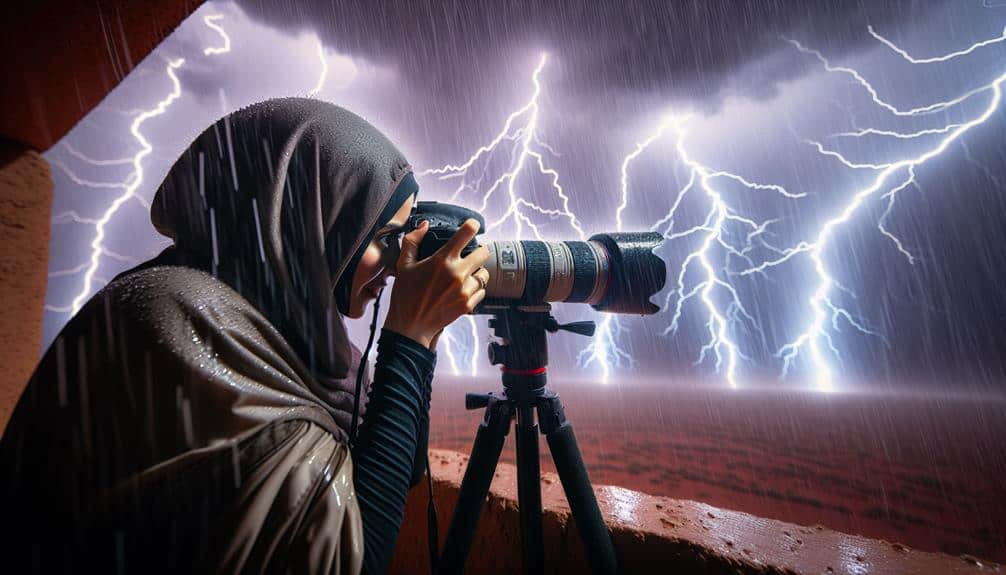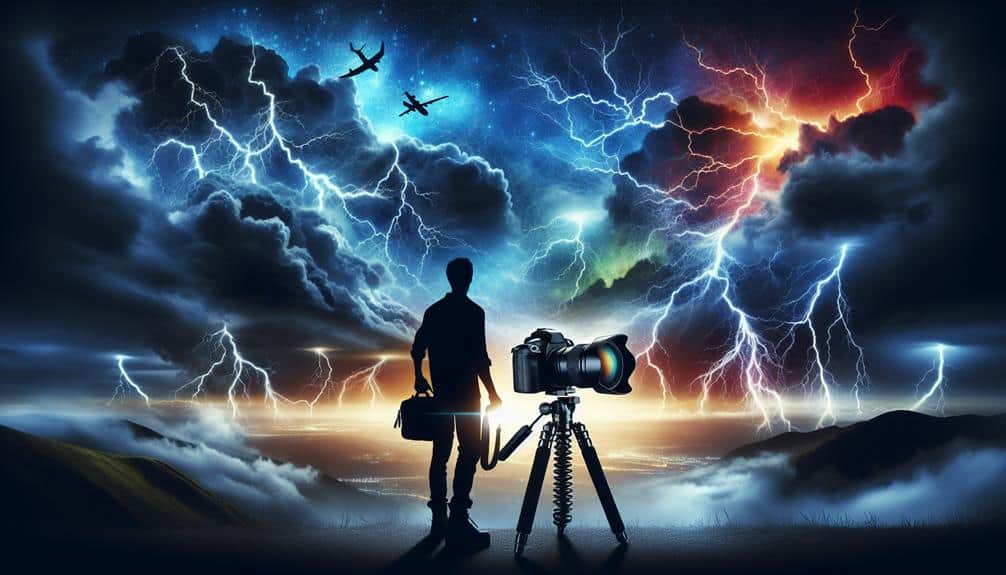We find lightning strike images mesmerizing because they showcase the powerful, instantaneous release of energy as electrical charge separation within thunderclouds leads to a rapid discharge. These photographs highlight the complex storm dynamics involving updrafts, downdrafts, and the potent electric fields they create. Capturing such awe-inspiring phenomena demands precise meteorological data, specialized gear like high-speed cameras, and impeccable timing. The juxtaposition of raw natural power and the technical prowess needed to frame these moments creates a captivating blend that keeps us intrigued. To fully appreciate the artistry and science behind these shots, there's more to discover.
Key Points
- Lightning strike images capture the raw, untamed power of nature, evoking a sense of awe and wonder.
- The dramatic contrast between bright lightning and dark storm clouds creates visually stunning compositions.
- Lightning photos showcase the fleeting and rare beauty of a natural phenomenon, making each shot unique.
- The intricate patterns and branching of lightning bolts add a complex and mesmerizing visual element.
The Science Behind Lightning
Understanding the science behind lightning involves exploring the detailed processes of electrical charge separation and discharge within storm clouds. When we investigate thunderstorm dynamics, we find that these atmospheric phenomena begin with the movement of air and water droplets. As updrafts and downdrafts circulate within the storm, collisions between ice particles and water droplets cause an accumulation of electrical charges.
This charge separation creates a potent electric field. When the potential difference between the storm cloud and the ground—or between different regions within the cloud—becomes significantly large, it results in an electrical discharge. This is the lightning strike we see, a rapid release of energy that heats the air to temperatures as high as 30,000 Kelvin, causing the characteristic flash and thunder.
Weather patterns play an essential role in these processes. Variations in temperature, humidity, and wind speed can notably influence storm development and the likelihood of lightning. By studying these factors, we gain insights into predicting storm behavior and improving safety measures.
Understanding the complex interplay of these elements not only captivates us but also empowers us to better navigate the potent and unpredictable forces of nature.
The Thrill of the Chase
Chasing lightning offers an exhilarating blend of scientific discovery and high-stakes adventure, pushing us to capture fleeting moments of raw atmospheric power. The adrenaline rush we experience as storm photographers is unparalleled. We often find ourselves braving extreme weather conditions, driven by a photography passion that demands precision and quick thinking.
When we set out to document a thunderstorm, we rely on meteorological data to predict lightning activity. Doppler radar and satellite imagery guide us to potential hotspots, where the probability of capturing a strike is highest. Our vehicles are equipped with specialized gear, including lightning triggers and high-speed cameras, designed to seize those split-second instances of electrical discharge.
The intersection of skill and chance is where the magic happens. Each successful shot is a tribute to our ability to anticipate and react under pressure. We immerse ourselves in the chaos of nature, yet maintain a disciplined focus on the task at hand.
This duality fuels our storm photography, turning each outing into a calculated but thrilling quest. The pursuit of capturing lightning isn't just about the end result; it's about the journey and the freedom it represents.
Techniques for Stunning Photos
Mastering the art of capturing stunning lightning photos hinges on utilizing precise camera settings, strategic positioning, and advanced equipment. First, let's explore composition tips. Positioning ourselves to frame the shot effectively is essential. We should aim for a vantage point that includes both the storm and the surrounding landscape to provide context and depth.
Next, we need to discuss exposure settings. Lightning is incredibly bright and brief, so manual settings are necessary. A low ISO (100-200) minimizes noise, while a small aperture (f/8 to f/11) ensures a wider depth of field. The shutter speed should be set to bulb mode, allowing us to control exposure duration manually.
To create rhythm and flow, here's a structured approach:
- Select a stable tripod: Guarantees zero camera shake, maintaining sharpness.
- Use a remote shutter release: Prevents camera movement during long exposures.
- Monitor weather radar apps: Helps predict lightning activity for the best positioning.
- Employ intervalometer: Facilitates capturing multiple exposures without manual intervention.
Essential Gear for Storm Chasers
In storm chasing, having the right gear can mean the difference between capturing a breathtaking lightning shot and missing the moment entirely. Our primary tool is a high-quality DSLR or mirrorless camera with a fast shutter speed and high ISO capabilities. These features ensure we can capture sharp, well-exposed images even in low light conditions typical of thunderstorms.
A sturdy tripod is non-negotiable. Stability is vital when using long exposure times to photograph lightning. Without it, even the slightest movement can blur our images, rendering them useless. Additionally, a remote shutter release or intervalometer helps minimize camera shake, allowing us to take multiple shots in quick succession without touching the camera.
We also need a wide-angle lens, preferably with a focal length of 14-24mm. This lens type captures a broader portion of the sky, increasing our chances of framing the perfect lightning bolt.
Don't forget weather-resistant gear. Many cameras and lenses offer weather sealing, essential for protecting our photography equipment from rain and dust.
Lastly, we rely on real-time weather apps and lightning detection tools. These help us anticipate where and when lightning will strike, giving us the freedom to position ourselves at the best vantage point for the shot.
Safety Tips for Photographers

While capturing stunning lightning images is our goal, we must prioritize our safety amidst the inherent dangers of storm chasing. Lightning awareness and proper positioning are essential to mitigating risks. We need to understand that lightning can strike up to 10 miles away from a storm, making it imperative to stay informed and prepared.
Here are four essential safety tips for photographers:
- Monitor Weather Reports: Utilizing reliable meteorological data helps us anticipate storm movements and lightning activity. Real-time radar and lightning detection apps are valuable tools.
- Maintain Proper Positioning: Position ourselves at a safe distance from the storm. The National Weather Service recommends staying at least 6 miles away from the storm's core to avoid being within the strike range.
- Seek Safe Shelter: If lightning is imminent, our safest bet is to seek shelter in a fully enclosed building or a metal-topped vehicle. Avoid open fields, tall trees, and water bodies.
- Use Remote Triggers: Employ remote camera triggers to capture lightning from a safe distance. This minimizes exposure to the elements and potential strikes.
Frequently Asked Questions
How Do Lightning Strike Images Impact Social Media Engagement?
We see lightning strike images greatly boost social media engagement metrics. These visuals often become viral content, enhancing brand promotion. Influencer partnerships using such images can drive impressive engagement metrics, amplifying reach and freedom in content creation.
What Cultural Significance Do Lightning Strikes Have in Different Societies?
We might think lightning's just a natural phenomenon, but it holds rich folklore interpretations and cultural rituals globally. From superstitions to symbolic meanings, societies often see lightning as divine messages, influencing their freedoms and actions.
Are There Famous Historical Photos of Lightning Strikes?
We've seen iconic moments captured by famous photographers, like Harold Edgerton's 1931 lightning strike photo. These images hold historical significance and exemplify visual storytelling, using scientific accuracy and technical mastery to document nature's raw power.
Can Lightning Strike Images Be Used for Scientific Research?
Like a modern-day Prometheus, we harness lightning strike images for meteorological analysis and electrical discharge studies. Advanced photography techniques capture atmospheric phenomena, enabling precise scientific research and data-driven insights, revealing nature's secrets for those who seek freedom in knowledge.
How Do Artists Incorporate Lightning Imagery Into Their Work?
Artists use lightning imagery to draw artistic inspiration and foster creative expression. They often utilize its symbolism and dynamic nature in visual storytelling, adding depth and intensity to their work through precise, data-driven techniques.


